Gain insight into the sycamore fig tree's biblical significance and its enduring symbol of redemption, leaving you eager to explore its deep roots.
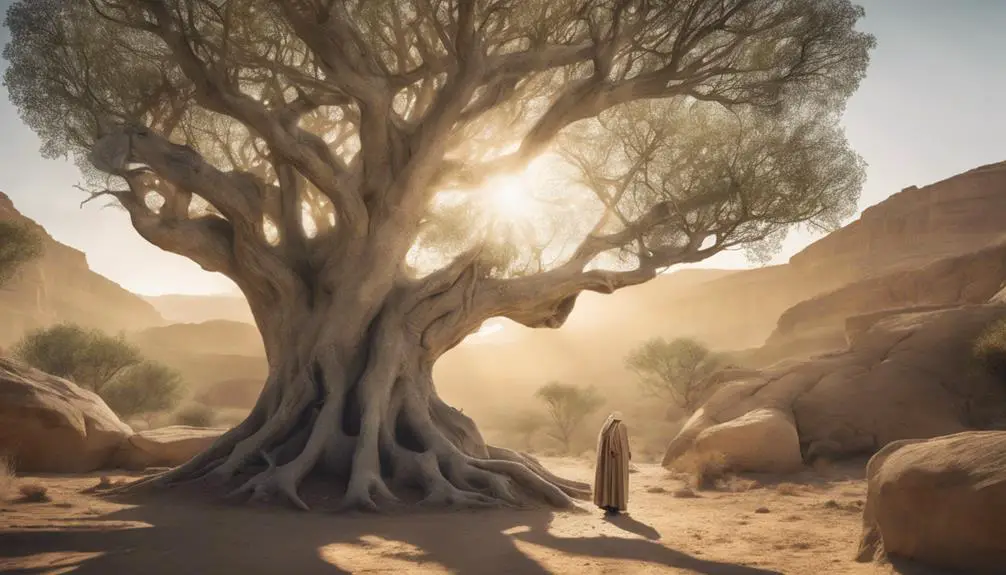
Sycamore Fig Tree in the Bible
Just as the sycamore fig tree stood tall in the biblical narrative of Zacchaeus, it also stands prominently within the tapestry of scriptural symbolism and history. You'll find its roots deeply embedded in cultural, religious, and even ecological discussions spanning centuries.
From Zacchaeus' memorable encounter, which highlights themes of redemption and visibility, to the tree's symbolic representation of protection and abundance, there's a rich vein of interpretation and significance yet to be explored.
As you consider the sycamore fig tree's journey through biblical times to its relevance today, you're invited to uncover the layers of meaning that have perhaps been overlooked or underestimated.
Key Takeaways
- The sycamore fig tree symbolizes spiritual growth, divine connection, and steadfast faith in biblical narratives.
- It represents God's provision and protection, with its broad branches and abundant fruit reflecting divine care.
- Biblical references to the sycamore fig tree embody themes of visibility, redemption, and personal transformation.
- Beyond its biblical significance, the tree symbolizes a bridge between the sacred and secular, highlighting its ecological and cultural importance.
Historical Significance
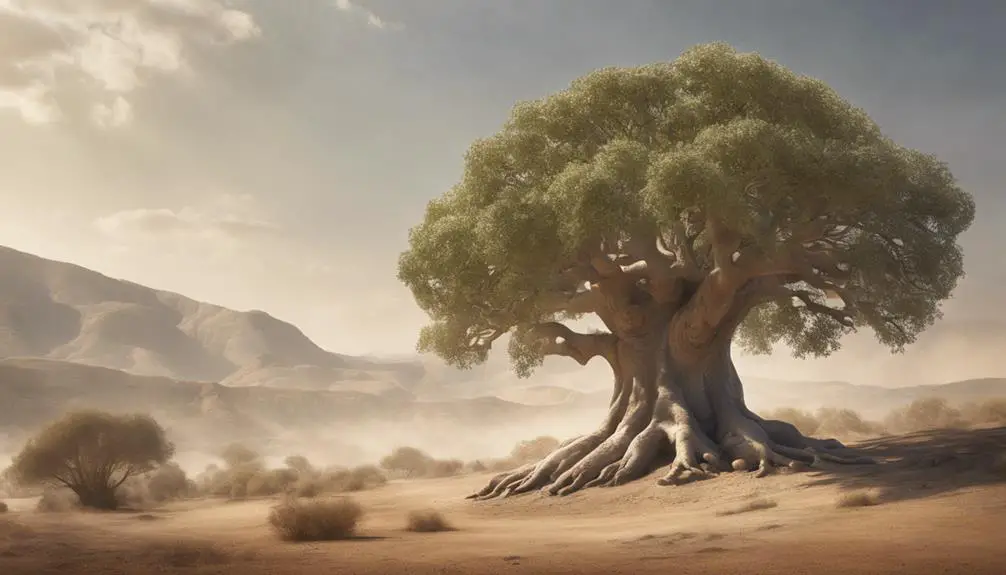
Throughout history, the Sycamore fig tree has held profound significance in various religious and cultural narratives, often symbolizing sustenance, prosperity, and divine encounters. You'll find that its roots extend deeply not only into the soil but also into the annals of ancient cultivation and geographic distribution, marking it as a staple of ancient societies.
The ancient cultivation of the Sycamore fig tree, particularly in the Middle East and parts of Africa, reveals its critical role in sustaining early civilizations. Its ability to thrive in diverse climates and its generous yield of fruit, sometimes multiple times a year, made it indispensable. You're looking at a species that didn't just feed the body but also nourished the soul, playing a pivotal role in religious rituals and offerings.
Geographic distribution further underscores its historical significance. The tree's prevalence in Egypt, for instance, wasn't just a matter of ecology but of deep spiritual and economic importance. The Sycamore fig was so revered that it was often planted near tombs and in sacred spaces, symbolizing eternal life and connection between the earthly and the divine.
Analyzing the Sycamore fig tree's place in history, you can't help but appreciate how it bridged the natural and spiritual worlds for ancient peoples. Its widespread cultivation across different regions wasn't merely a testament to its adaptability but also to its integral role in the fabric of ancient society, intertwining with the very essence of prosperity, sustenance, and divine presence.
Zacchaeus' Memorable Encounter
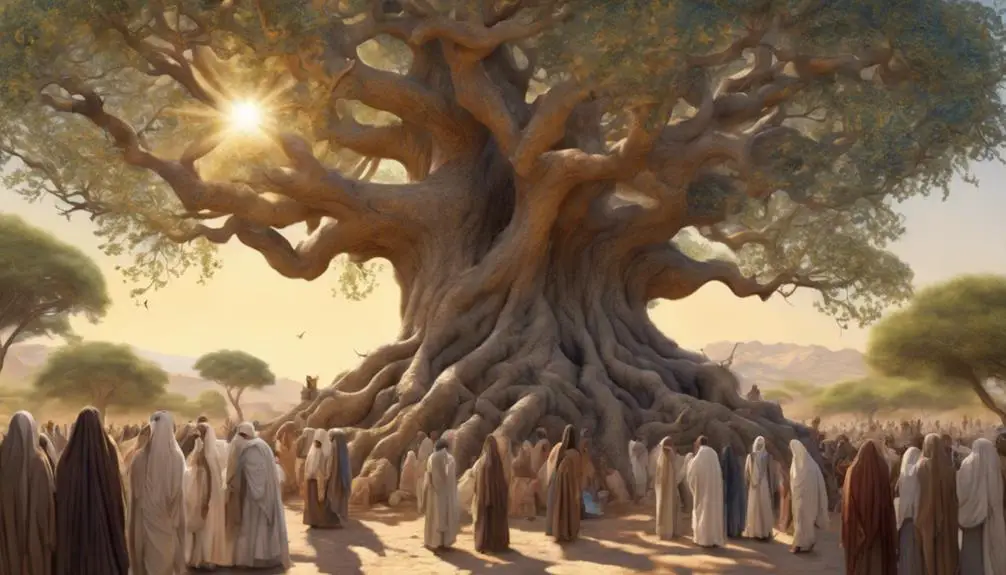
One of the most poignant biblical narratives featuring the Sycamore fig tree unfolds in the Gospel of Luke, where Zacchaeus, a tax collector, climbs into its branches to catch a glimpse of Jesus. This act of tree climbing, performed by a man of Zacchaeus' social and economic stature, is laden with theological and historical implications.
As a tax collector, Zacchaeus was marginalized by the Jewish society of his time, viewed as a collaborator with the Roman occupiers, and thus, ritually unclean and a sinner in the eyes of his people.
His decision to climb the Sycamore fig tree isn't merely a physical act to overcome the obstacle of the crowd; it symbolizes his desperate yearning for salvation and recognition from Jesus, breaking the social barriers that defined his existence. The tree, in this context, becomes a bridge between Zacchaeus' state of isolation and Jesus' message of inclusion and redemption.
Jesus' response to Zacchaeus' tree climbing is equally significant. By acknowledging Zacchaeus and choosing to dine at his house, Jesus dismantles the prevailing socio-religious norms that ostracized tax collectors. This encounter underlines the theme of Jesus' ministry, emphasizing God's love and grace extending to even the most despised and marginalized individuals in society.
Thus, Zacchaeus' memorable encounter with Jesus, facilitated by his ascent of the Sycamore fig tree, encapsulates a profound theological message of redemption, inclusion, and the breaking down of societal barriers, reinforcing the transformative power of faith and divine grace.
Symbolism and Interpretation

In exploring the symbolism and interpretation of the Sycamore fig tree within biblical narratives, it's crucial to understand how this tree serves not just as a physical entity, but as a profound emblem of spiritual growth and divine connection. The imagery of trees, particularly the Sycamore, weaves through the scriptures, offering layers of meaning that transcend their botanical origins. You'll find that tree metaphors are abundant, each carrying its own unique spiritual significance.
The Sycamore fig tree, with its sturdy trunk and extensive canopy, symbolizes protection and sustenance, mirroring the shelter and nourishment provided by faith in the divine. Its widespread roots suggest a deep, anchored faith that withstands trials. Moreover, the act of climbing the Sycamore to see Jesus, as Zacchaeus did, is often interpreted as an allegory for spiritual growth – ascending above the worldly to gain a clearer vision of the divine.
Aspect |
Significance |
|---|---|
Sturdy Trunk |
Represents steadfast faith that supports spiritual growth. |
Extensive Canopy |
Symbolizes the encompassing protection and sustenance offered by divine connection. |
Widespread Roots |
Implies a deep, anchored faith resilient to life's trials. |
This tree's presence in biblical stories isn't accidental but purposeful, inviting you to ponder your own journey of faith. Just as the Sycamore fig tree stands resilient and nurturing, you're called to cultivate a faith that is both deeply rooted and expansive, reaching out to embrace the lessons of the divine. Through this lens, the Sycamore isn't just a tree but a metaphor for spiritual growth and divine connection, guiding you toward a deeper understanding of your spiritual journey.
Cultural Impact
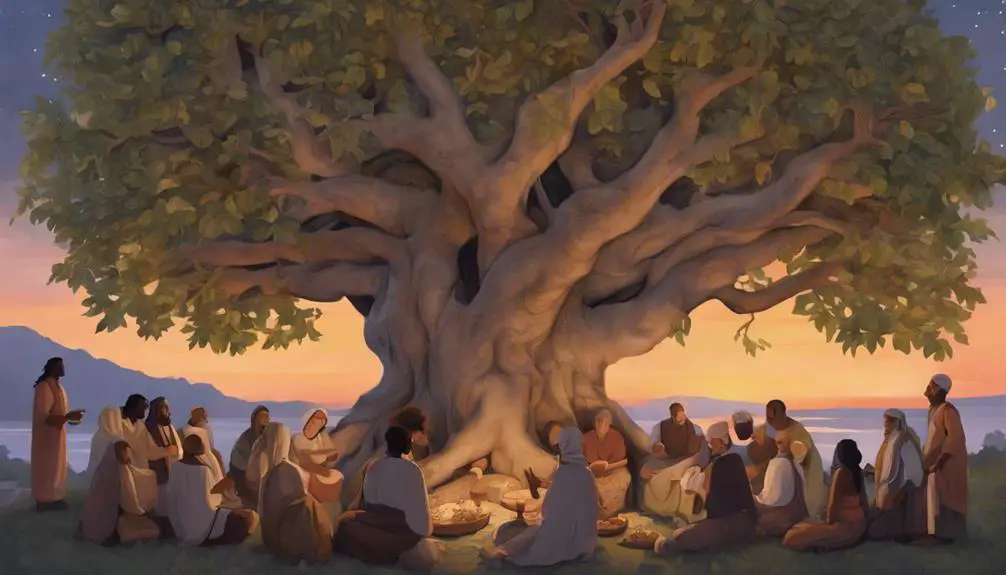
The cultural impact of the Sycamore fig tree extends beyond its biblical mentions, shaping societies and faith practices across ages. Historically, this tree hasn't only been a source of sustenance but also a symbol deeply woven into the fabric of religious narratives. Its fruits have inspired a myriad of fig recipes, passed down through generations, intertwining culinary tradition with spiritual significance. These recipes often carry stories of community, family, and faith, serving as a reminder of the tree's enduring relevance.
In theological discourse, the Sycamore fig's presence is a testament to its importance in ancient societies. Its robustness and the abundance of its fruit have been paralleled with spiritual nourishment and resilience, themes that are prevalent in religious teachings. This parallel has allowed the tree to remain a symbol of sustenance and steadfastness in the face of adversity, resonating with many believers' experiences.
Furthermore, religious art has immortalized the Sycamore fig tree, embedding it within the visual culture of faith communities. Its depiction in paintings, stained glass, and tapestries serves as a visual testament to its significance. Through these artistic expressions, the tree's symbolic meaning is communicated, bridging the gap between scripture and the visual arts. This fusion of art and faith highlights the tree's capacity to inspire and evoke contemplation, making its image a powerful tool in religious expression.
Biblical References
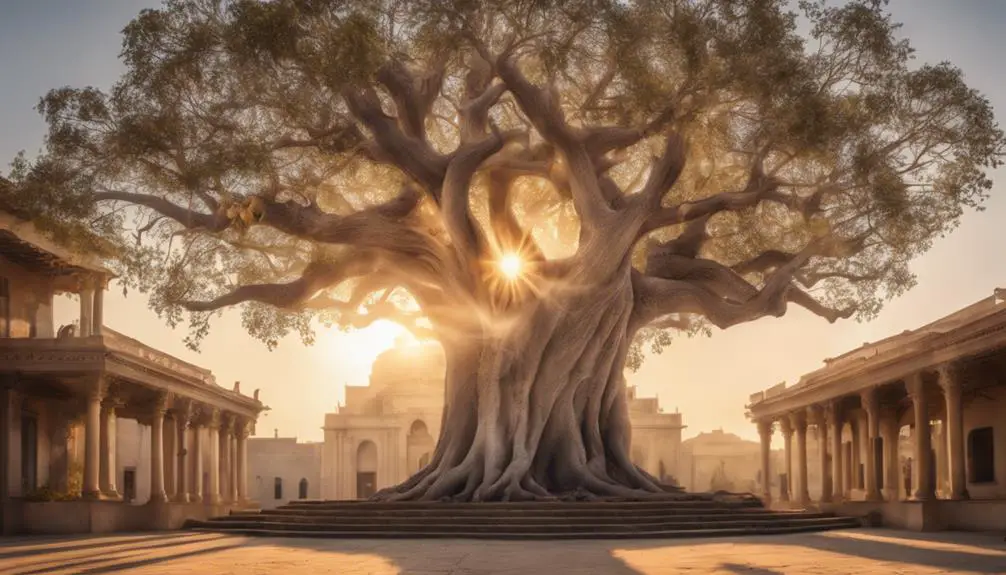
Throughout the Bible, you'll find that the Sycamore fig tree not only graces narratives with its presence but also carries profound symbolic weight, underscoring themes of growth, sustenance, and renewal. This tree, with its detailed plant descriptions in scripture, serves as more than just a backdrop for biblical events. Its broad, sheltering branches and prolific fruit production speak volumes about the provision and care inherent in the divine narrative.
The geographical distribution of the Sycamore fig, primarily in the Middle Eastern region, particularly in Egypt and Israel, aligns with many of the Bible's stories. It thrives in both hot, arid climates and more temperate zones, symbolizing adaptability and resilience. You're likely familiar with the story of Zacchaeus in the Gospel of Luke, where this tax collector climbs a Sycamore tree to see Jesus. This incident isn't just a physical act; it represents a spiritual quest for visibility, redemption, and change, with the tree literally and figuratively supporting this transformation.
Moreover, the Sycamore fig's extensive root system and longevity resonate with themes of deep faith and enduring legacy in biblical texts. Its ability to grow in challenging environments mirrors the biblical message of hope and perseverance amidst adversity.
Analyzing these references further, you'll discover that the Sycamore fig's presence in the Bible isn't coincidental. Its characteristics and the roles it plays in various narratives are carefully chosen to reflect theological truths and human experiences, making it a powerful symbol of God's provision, protection, and the potential for personal growth and renewal.
Modern Relevance
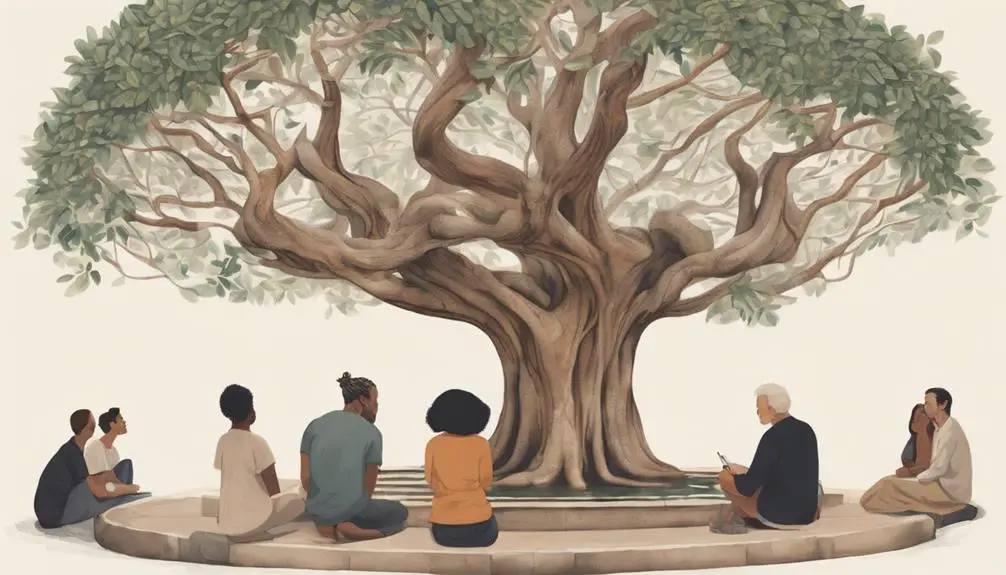
While ancient texts anchor the Sycamore fig firmly in biblical narratives, its significance extends into today's discussions on faith, ecology, and cultural heritage. You'll find that this venerable tree, once a backdrop for profound spiritual teachings, now serves as a beacon for ecological conservation and sustainable agricultural practices. The Sycamore fig's deep roots in history offer a unique perspective on how ancient wisdom can guide modern environmental stewardship.
In your exploration of its modern relevance, you'd see how the Sycamore fig transcends its biblical origins to embody principles of ecological balance. Its ability to thrive in arid conditions makes it a pivotal species in the fight against desertification, a pressing issue in many parts of the world where biblical history unfolded. By highlighting its role in maintaining ecological integrity, you're invited to consider how ancient trees can inform current environmental strategies.
Moreover, the Sycamore fig's impact on agricultural practices can't be understated. Its fruit, once a staple for ancient civilizations, today offers insights into sustainable farming techniques. By examining its cultivation, you're delving into a historical agricultural practice that reflects a harmonious relationship with the land, a concept profoundly relevant in today's quest for sustainable food sources.
Thus, the story of the Sycamore fig bridges the gap between the sacred and the secular, demonstrating how biblical symbols can foster a deeper appreciation for our environmental and cultural heritage. In this light, you're encouraged to view the Sycamore fig not just as a relic of the past but as a living testament to the enduring interplay between faith, ecology, and human ingenuity.
Frequently Asked Questions
How Does the Care and Cultivation of Sycamore Fig Trees in Ancient Times Compare to Modern Agricultural Practices for These Trees?
You're diving into how ancient sycamore fig tree care contrasts with today's methods. Back then, techniques were purely organic, relying on natural processes.
Nowadays, you've got modern pesticides and genetic modification at your disposal, significantly boosting yield and disease resistance.
This shift not only reflects technological advances but also a departure from traditional, naturalistic approaches.
You're witnessing a melding of history and innovation in the cultivation of these timeless trees.
Are There Notable Differences Between the Sycamore Fig Tree Mentioned in the Bible and Other Fig Tree Species Found in Different Parts of the World Today?
Yes, there are notable differences between the sycamore fig tree species you're curious about and other fig tree species worldwide.
Fossil records and genetic diversity studies reveal that these variations aren't just superficial but extend to genetic makeup and historical roles in ecosystems.
While all fig trees share some common traits, the sycamore fig's unique characteristics distinguish it from its relatives, reflecting its special place in history and theology.
How Have Representations of the Sycamore Fig Tree in Biblical Art and Literature Evolved Over the Centuries?
You've noticed that artistic symbolism and cultural perceptions of fig trees in art and literature have shifted dramatically over centuries. Initially, their depictions were likely rooted in theological and historical contexts, symbolizing sustenance and prosperity.
However, as cultural perceptions evolved, so did the artistic representation, weaving deeper symbolic meanings, from spiritual growth to resilience. This evolution reflects broader changes in society's values and the way nature's elements are interpreted and valued.
What Specific Environmental Conditions Are Required for Sycamore Fig Trees to Thrive, and How Were These Conditions Met in the Regions Mentioned in the Bible?
To ensure sycamore fig trees thrive, they need specific environmental conditions. These include warm climates and well-drained soils. In historical regions, climate adaptation played a crucial role.
The trees adapted to various soil types, from sandy to loamy. This adaptability meant they could grow in diverse areas, aligning with historical references.
Understanding these conditions helps you appreciate their significance and resilience, reflecting a deeper theological and historical connection to the land.
Can the Sycamore Fig Tree Be Grafted With Other Species of Fig Trees, and Were Such Practices Ever Mentioned or Alluded to in Historical or Biblical Texts?
You're diving into the fascinating world of grafting techniques, pondering whether the sycamore fig tree can unite with other fig species. It's like mixing the DNA of ancient kings—does genetic compatibility allow for such a royal blend?
Historically and theologically, there's no clear evidence or biblical mention of these arboreal unions. Yet, the idea isn't far-fetched. Both science and scripture suggest a deep understanding of nature's complex relationships, hinting at possibilities beyond our imagination.
Conclusion
As you've journeyed through the tales and truths of the sycamore fig tree in the Bible, you've uncovered its deep historical roots, witnessed Zacchaeus' transformative encounter, and delved into its rich symbolism and cultural resonance. These biblical references and their modern relevance challenge us to look beyond the surface.
But what if there's more to its story, lurking in the shadows of history and faith? The sycamore's legacy prompts us to question, explore, and perhaps, rediscover our spiritual landscape anew.


Sign up